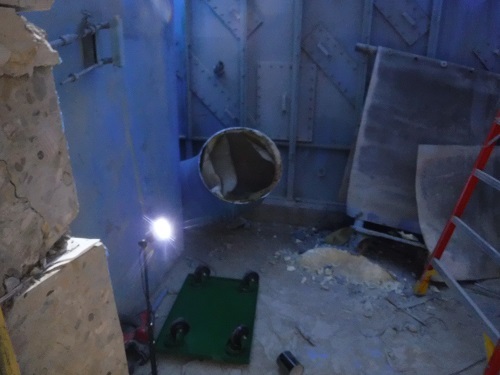 A crew member at the Hanford Site's Waste Treatment and Immobilization Plant holds a handful of small carbon pellets loaded into the emissions treatment system in the Low-Activity Waste Facility.
RICHLAND, Wash. – The Hanford Site’s Waste Treatment and Immobilization Plant team recently completed loading approximately 55,000 pounds of small carbon pellets into the emissions treatment system of the Low-Activity Waste (LAW) Facility.
Roughly 2,160 cubic feet of the pea-sized pellets, enough to fill five dump trucks, were loaded into units known as carbon bed adsorbers, which will treat emissions by removing mercury.
The carbon bed adsorbers are part of the LAW Facility’s larger off-gas treatment system that cleans, filters and scrubs the emissions generated by the facility’s two melters during waste vitrification when radioactive and chemical waste and glass-forming materials are heated to 2,100 degrees Fahrenheit. Melter emissions will be treated to remove particulates, mercury, nitrogen oxides, volatile organic compounds and acid gasses.
“Loading the carbon bed adsorbers is an important step in readying the LAW Facility emissions treatment system for operations,” said Rick Holmes, general manager for Waste Treatment Completion Company, a subcontractor to project lead Bechtel National, Inc. “The system will protect workers, the public and the environment and ensure we meet state and federal regulatory standards during operations.”
During Direct-Feed Low-Activity Waste operations, waste treated to remove radioactive cesium and solids at a tank farm will be fed directly to the LAW Facility’s melters. The waste and glass-forming materials will be mixed, heated and poured into specially designed stainless-steel containers. The containers will be transported a short distance to the site’s Integrated Disposal Facility for disposal.
-Contributor: Tyler Oates
WEST VALLEY, N.Y. – Workers at the West Valley Demonstration Project (WVDP) recently removed a large ventilation duct from the Main Plant Process Building, another step in reducing risk and preparing the facility for demolition, an EM 2022 priority.
As part of deactivation activities, crews finished cutting and removing the 26-inch-diameter duct that carried exhaust from past operations at the building.
“The effort in the Vent Wash Room was successful because of the extensive planning, and deliberate and safe execution of the work,” said Steve Bousquet, EM’s WVDP deputy federal project director for the Main Plant project. “The WVDP team continues DOE’s mission to reduce legacy risks while protecting employees, the public and the environment.”
 |
|
A section of a ventilation duct inside the Vent Wash Room at the Main Plant Process Building is shown before it was cut remotely with a diamond wire saw. The completed project involved 28 separate cuts to safely remove 19 sections of the duct. |
As part of deactivation activities inside the Vent Wash Room at the Main Plant Process Building, a section of a 26-inch ventilation duct, shown here prior to removal, was cut by a diamond wire saw. |
|
 |
EM and its WVDP prime contractor, CH2M HILL BWXT West Valley (CHBWV), completed 28 cuts and removed 19 sections of the duct from the room within the Main Plant. Workers performed this deactivation work remotely to avoid potential radiation exposure.
“This team used teamwork, lessons learned and feedback throughout the process to accomplish this work activity safely,” said Tom Dogal, CHBWV facility disposition manager. “The WVDP team should be commended for safely performing the work while in a confined space with layers of protective clothing, using remote tools and adhering to enhanced COVID-19 protocols.”
The Vent Wash Room served as a support area for the former reprocessing cells inside the building. It housed a ventilation "scrubber” that removed airborne particulates resulting from fuel reprocessing operations that ceased in 1972. The scrubber has been prepared for removal during the Main Plant demolition.
Several other areas within the Main Plant — including the product purification and chemical process cells, and a fuel receiving and storage facility — sent exhaust to the room through the ductwork. The exhaust was then directed to a ventilation exhaust cell where it was filtered before being discharged to the plant’s stack.
-Contributor: Joseph Pillittere
|